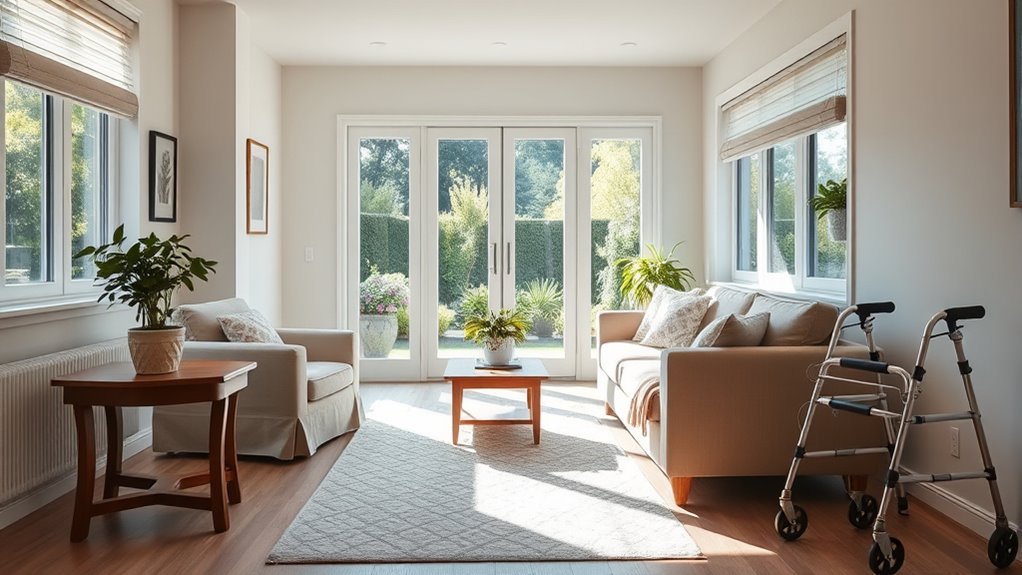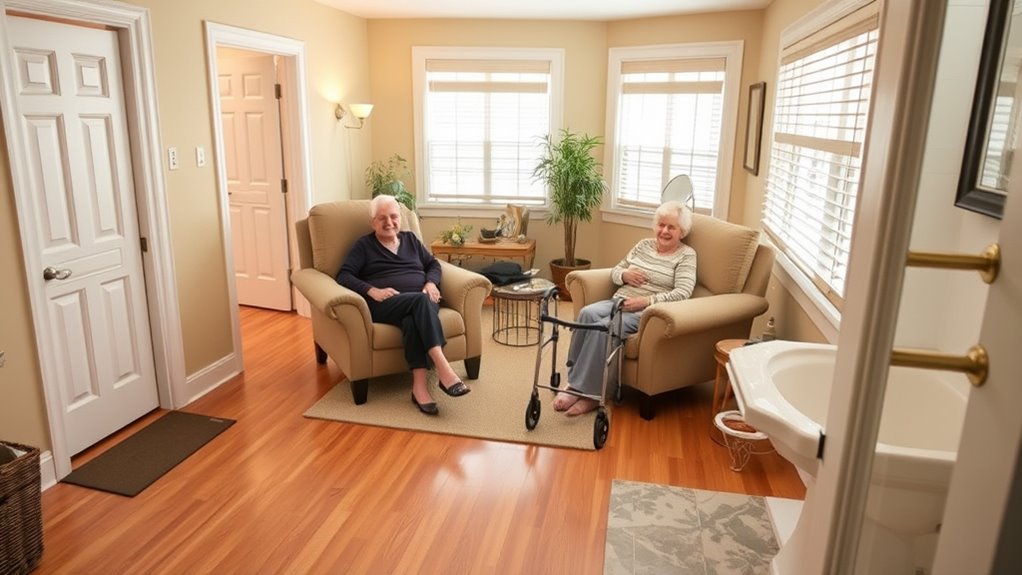To plan to age in place safely, start by making essential home modifications like grab bars, ramps, and wider doorways to improve accessibility and reduce fall risks. Consider your future needs and consult professionals to identify effective adjustments. Leverage community resources like transportation and support programs to fill any gaps. Creating a detailed plan that combines these changes ensures you stay safe, independent, and comfortable over time — and there’s more to explore to help you succeed.
Key Takeaways
- Conduct a home safety assessment to identify and address potential hazards proactively.
- Implement necessary modifications like grab bars, ramps, and widened doorways to enhance accessibility.
- Plan for future needs by considering mobility changes and consulting professionals for personalized solutions.
- Utilize community resources such as transportation, home care, and social programs to support independence.
- Develop a comprehensive aging-in-place plan combining home modifications and community support to ensure safety over time.

Aging in place offers many seniors the comfort of staying in familiar surroundings, but it requires careful planning to do so safely. One of the most effective ways to guarantee your home remains a safe environment is through thoughtful home modifications. These changes can include installing grab bars in the bathroom, adding ramps at entryways, or widening doorways to accommodate mobility devices. Such modifications help prevent falls and make daily activities easier, giving you greater independence. You don’t need to overhaul your entire home; simple adjustments targeted at your specific needs can make a significant difference. It’s also important to contemplate your future needs, so your home remains accessible as your mobility or health changes. Consulting with professionals experienced in aging-in-place modifications can provide insights into the most practical solutions.
Equally important is leveraging community resources to support your goal of aging in place. Many communities offer programs and services tailored for seniors, such as transportation assistance, meal delivery, or in-home care. These resources can fill gaps that might otherwise force you to move or rely heavily on family members. Local senior centers, healthcare providers, and non-profit organizations often provide valuable support networks, social activities, and educational programs that keep you engaged and connected. Accessing these resources can enhance your safety and well-being, making it easier to stay independent. For example, some communities have volunteer programs that assist with home repairs or yard work, reducing the physical strain on you. Others might offer safety assessments for your home, identifying hazards and recommending improvements.
Planning ahead means knowing what community resources are available and how they can assist you. You should research what services exist in your area and consider how they align with your needs. Signing up for local senior programs or connecting with social services early on can help you build a network of support before emergencies arise. Additionally, staying informed about technological solutions—like emergency alert systems or remote health monitoring—can further increase your safety at home. By combining smart home modifications with a proactive approach to utilizing community resources, you create a comprehensive plan that promotes independence and reduces risks.
Ultimately, aging in place successfully depends on your ability to adapt your environment and tap into available support systems. Careful planning ensures your home remains safe and accessible, while community resources fill in the gaps, providing assistance when needed. With thoughtful modifications and an active connection to community programs, you can enjoy the comfort of your familiar surroundings while maintaining your independence and safety for years to come.
Frequently Asked Questions
How Can I Finance Home Modifications for Aging in Place?
You can finance home modifications for aging in place through your home equity by tapping into a home equity loan or line of credit. Additionally, explore government grants and assistance programs designed for senior home improvements. These options help cover costs and make your home safer and more accessible. Be sure to compare the terms and eligibility requirements to find the best fit for your financial situation.
What Legal Documents Should I Prepare for Aging at Home?
You should prepare essential legal documents like a power of attorney and advance directives. A power of attorney allows someone you trust to handle your financial and healthcare decisions if you become unable to do so. Advance directives specify your medical wishes, ensuring your care aligns with your preferences. These documents give you peace of mind, helping you age at home safely and on your terms.
How Do I Choose the Right Home Care Services?
To select the right home care services, start by researching various home care options available in your area. Compare service providers based on their reputation, experience, and the specific services they offer. Consider your needs and preferences, such as assistance with daily activities or medical care. Meet with potential providers, ask questions, and check references to guarantee you find a trustworthy, compatible partner to support your independence and safety at home.
What Technology Options Assist Safe Aging in Place?
You can use smart home technology to help you age in place safely. Installing a smart home system allows you to control lighting, locks, and thermostats easily. Emergency alerts are essential—they notify you or emergency services quickly if there’s a problem. These tools provide peace of mind, so you stay independent while ensuring safety. With the right smart home setup and emergency alerts, you can confidently manage daily tasks and respond to emergencies promptly.
How Can I Involve Family in My Aging-In-Place Plan?
Think of your family as the sturdy branches of a tree supporting you. To involve them, keep communication open—share your needs and plans honestly. Encourage elder advocacy by asking for their input and assistance. Regularly check in, create a support network, and involve them in decision-making. Their involvement acts as a safety net, providing emotional strength and practical help, ensuring your age-in-place journey is both secure and connected.
Conclusion
By taking proactive steps today, you can guarantee your home remains a safe haven for years to come. Picture yourself comfortably living out your golden years, much like a wise sage in a cozy cottage. Remember, planning ahead isn’t just smart—it’s essential. So, don’t wait for a ‘knight in shining armor’ to rescue you; be your own hero now, and create a safe, inviting space that ages with you gracefully.









